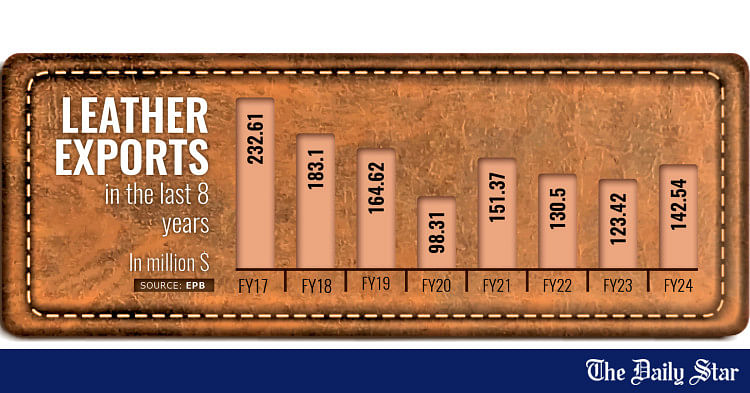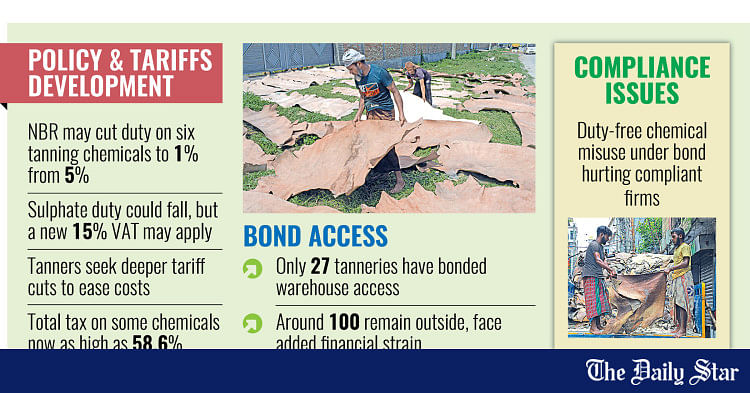Saif
Senior Member
- Jan 24, 2024
- 12,666
- 7,017
- Origin

- Residence

- Axis Group


Leather sector lagging 30yrs behind: experts
Speakers at a discussion meeting on Sunday said that the Bangladesh leather industry has been going through a tough situation over the past 10 years...
 www.newagebd.net
www.newagebd.net
Leather sector lagging 30yrs behind: experts
United News of Bangladesh . Dhaka 27 April, 2025, 22:49

New Age file photo
Speakers at a discussion meeting on Sunday said that the Bangladesh leather industry has been going through a tough situation over the past 10 years.
The types of leather that were produced in Bangladesh 20 to 30 years ago are still being produced without any change. There is no development in this regard. So the leather sector is lagging behind, they said.
‘In 2012, the revenue from the leather sector was US $1.13 billion. In 2024, it decreased to $970 million,’ the discussion was told on the occasion of ‘World Leather Day 2025’ at the Leather Industry City in Harindhara, Savar, on Sunday.
Despite having potential and enough sources of rawhide in the country, other industries are developing, but the picture is the opposite in the leather Industries, they said.
The meeting was organised by Footwear Exchange at the seminar hall of Dhaka Tannery Industrial Estate Waste Treatment Plant Company Limited in Shilpanagar with the theme ‘Beyond the Surface: It’s Our Time to Be Visible, Vocal and Responsible’.
The meeting was moderated by Golam Shahnewaz, managing director of DTIEWTPCL, and the chief guest was Bangladesh Tanners Association (BTA) Chairman Shaheen Ahmed. Apex Tannery Chief Production Officer Salauddin Mahmud Khan, Managing Director of Marson Tannery Tariqul Islam Khan were the special guests.
Leather Engineers and Technologists Society of Bangladesh President Mohammad Ali, Leather Products and Footwear Manufacturers and Exporters Association (LFMEAB) Director Mushfiqur Rahman and others were present at the event.
BTA Chairman Shaheen Ahmed said that coordination between various industry-related associations is essential to overcome the crisis in the leather industry.
‘The institutions are not fully independent. The way BSCIC officials are running the industries ministry, it is being run the same way. In Kolkata, the owners of the leather industry institutions are the main stakeholders and shareholders. But in Bangladesh, it is completely the opposite,’ he said.
‘This needs to be fixed, the power of the association needs to be increased. The shares of tannery owners need to be increased,’ he added.
Speaking at the event, Mohammad Ali said that leather engineers have a big role in the development of the leather sector in Bangladesh. That role is not being played properly.
LFMEAB Director Mushfiqur Rahman said, ‘We are far behind in the demand for leather or footwear all over the world. We are always committed to the development of leather and leather products.’
United News of Bangladesh . Dhaka 27 April, 2025, 22:49
New Age file photo
Speakers at a discussion meeting on Sunday said that the Bangladesh leather industry has been going through a tough situation over the past 10 years.
The types of leather that were produced in Bangladesh 20 to 30 years ago are still being produced without any change. There is no development in this regard. So the leather sector is lagging behind, they said.
‘In 2012, the revenue from the leather sector was US $1.13 billion. In 2024, it decreased to $970 million,’ the discussion was told on the occasion of ‘World Leather Day 2025’ at the Leather Industry City in Harindhara, Savar, on Sunday.
Despite having potential and enough sources of rawhide in the country, other industries are developing, but the picture is the opposite in the leather Industries, they said.
The meeting was organised by Footwear Exchange at the seminar hall of Dhaka Tannery Industrial Estate Waste Treatment Plant Company Limited in Shilpanagar with the theme ‘Beyond the Surface: It’s Our Time to Be Visible, Vocal and Responsible’.
The meeting was moderated by Golam Shahnewaz, managing director of DTIEWTPCL, and the chief guest was Bangladesh Tanners Association (BTA) Chairman Shaheen Ahmed. Apex Tannery Chief Production Officer Salauddin Mahmud Khan, Managing Director of Marson Tannery Tariqul Islam Khan were the special guests.
Leather Engineers and Technologists Society of Bangladesh President Mohammad Ali, Leather Products and Footwear Manufacturers and Exporters Association (LFMEAB) Director Mushfiqur Rahman and others were present at the event.
BTA Chairman Shaheen Ahmed said that coordination between various industry-related associations is essential to overcome the crisis in the leather industry.
‘The institutions are not fully independent. The way BSCIC officials are running the industries ministry, it is being run the same way. In Kolkata, the owners of the leather industry institutions are the main stakeholders and shareholders. But in Bangladesh, it is completely the opposite,’ he said.
‘This needs to be fixed, the power of the association needs to be increased. The shares of tannery owners need to be increased,’ he added.
Speaking at the event, Mohammad Ali said that leather engineers have a big role in the development of the leather sector in Bangladesh. That role is not being played properly.
LFMEAB Director Mushfiqur Rahman said, ‘We are far behind in the demand for leather or footwear all over the world. We are always committed to the development of leather and leather products.’




